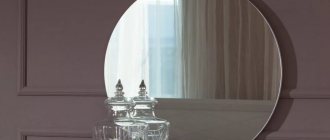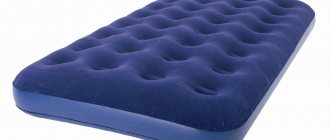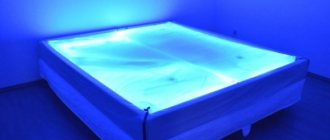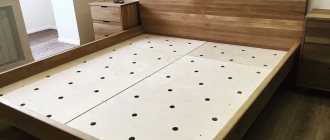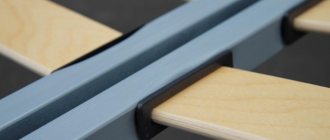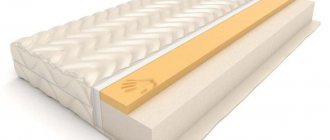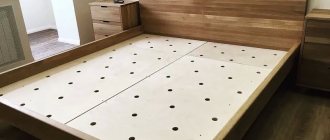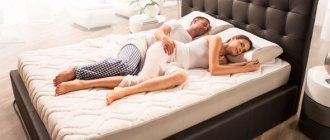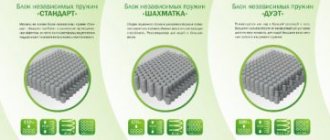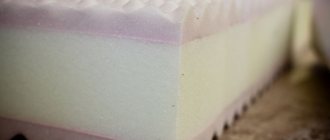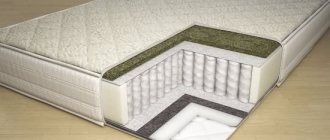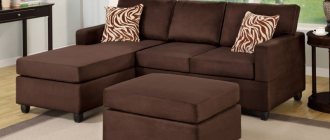11/07/2018 Category: Do it yourself
- 1 What you will need
- 2 Option one
- 3 Option two
- 4 What are the benefits
Times change, but children remain the same lovers of playing on the floor as in previous generations. And parents are still worried and worried that the child will catch a cold or get injured. A floor mattress made of pillows will solve all the mentioned problems at once. This “simple” product can be made on your own, even without any special sewing skills. And then you can play on it, read, lie down, watch TV, and even transform the mattress into a chair. But first... the product needs to be sewn!
Homemade orthopedic mattress
To make an orthopedic mattress with your own hands, you need the following materials
:
Dense polyurethane foam (for laying along the edge); Main filler; Fabric for the cover; Glue (it is important that it is safe, does not emit toxins or a strong odor, it will be needed for gluing the layers of filler).
The main filler will be foam rubber. It would be best to lay it in one piece. Layer-by-layer application together with PPU (polyurethane foam) of coconut fiber will improve the user properties of the bed. This is one way to make a mattress firmer, because moderate mattress firmness is very beneficial for the spine. In this way, mattresses of different hardness can be made. To do this, you need to lay coconut fiber on one side and foam rubber on the other.
Another solution is to use struttofiber, a dense material with vertical fibers, together with polyurethane foam. It will also provide good support for the spine. You can place struttofiber on both sides, and fill the middle with polyurethane foam, or you can alternate it with coconut slabs.
The cover is traditionally sewn from dense natural fabrics. The best for these purposes are calico and natural linen.
.
Master class on making
Before the production process begins, it is necessary to measure out the dimensions of the bed. To do this, you can use a tape measure. Then you can proceed to assembling the holding box (frame). The material for it will be dense polyurethane foam with a thickness of 50 to 100 mm.
It is advisable for the mattress to be at least 14-15 cm thick. If it is thinner, it will be uncomfortable to sleep on.
It is necessary to achieve accuracy in the dimensions of the bed and mattress components. This determines how strong and dense the final product will be. In addition, carefulness in size is necessary so that it lies tightly on the bed and does not slide to the sides, and the sleeping bed is stable.
After this, the filler is laid. If you manage to get a large solid piece of polyurethane foam of the required thickness, you need to measure the free space in the assembled frame and, using a stationery or shoe knife, evenly cut out the required fragment.
If the bed mattress consists of several foam layers, then the sheets are glued together. Otherwise, the product will not have the required density. The mattress will “walk” under a person lying on the bed.
How to sew a cover
Once the padding is made and placed in the box that holds it, you can begin making the mattress cover. The pattern should consist of two pieces of fabric with a margin for seams and side parts (usually about 3 centimeters on all sides).
The cover must be very dense so that it is put on with a certain effort, this will add strength and elasticity to the mattress. All seams must remain inside. To sew a durable and high-quality cover, you must use only natural fabrics and thick threads. You should not skimp on your health and comfort. Often, someone’s help is required to put on a cover, because it is quite difficult to pull the thick fabric evenly on oneself.
After the cover is stretched, it can be sewn up. However, for convenience, it is permissible to sew a zipper on one side. This cover is considered as permanent, not removable. But you need to sew a removable one on it, which will be equipped with two zippers. This is very convenient, because it can be removed and washed at any time.
If you don’t want to go to the trouble of sewing a cover at home, you can buy a mattress cover of a suitable size. True, it may need to be adjusted (if you have a child’s or non-standard size product).
The completed mattress will need to be ventilated in the fresh air. This will get rid of unpleasant odors of foam rubber or glue.
Attention, TODAY only!
Comfort and convenience during sleep are important aspects that allow the body to gain strength at night. The bed and mattress must be comfortable, the purchase of which often causes financial difficulties. Making a mattress with your own hands is an opportunity to save money, use the right materials, and be an interesting job.
Cutting out on fabric
Take a pattern and fabric, trace two identical blanks along the pattern with chalk. By the way, experienced seamstresses do not use crayons for this, but ordinary soaps. They are convenient to sharpen with scissors and are also easier to wipe off from the fabric after work. In addition, such thin pieces of soap do not smear your hands, unlike crayons, and draw a clear, thin line.
After the outline is transferred to the fabric, do the same with the batting. Then cut it out. At this stage, you will have three blanks: 2 identical fabric ones and one made of batting.
Preparing fabric for stitching
It will be necessary to quilt the mattress so that it does not bunch up when washed. You can do this manually with small frequent stitches, but it is better to quilt the product on a sewing machine. The lines can be straight - then you get neat squares. Or you can get creative and sew a mattress using original patterns - circles, flowers, snowflakes, waves.
You need to prepare the fabric for stitching in advance. On one of the cut-out pieces of fabric, you need to apply designs on the front side, which you will then use to quilt the mattress.
If the design is not just squares, but fantasy figures, they must first be prepared on paper. After you have cut them out, apply them at equal distances and trace them with chalk or sharpened soap.
Repair features
How I chose an orthopedic mattress
According to the place of use, mattresses are:
- for bed;
- for the sofa.
Independent
Self-upholstery of these types of soft products is almost the same, only the sofa ones have a more rounded surface and will require more lining material.
The DIY repair sequence is divided into the following stages:
- disassembly,
- trouble-shooting,
- assembly.
The most unpleasant stage is disassembly, because over the years of operation a lot of dust and dirt has accumulated inside the spring frame. Therefore, it is better to carry out all disassembly work on the street or in a non-residential premises, for example, in a barn or garage, and when working in residential premises it is recommended to have a vacuum cleaner on hand.
Parsed in the following order:
- The outer skin is removed. This is done by using pliers to pull out the nails or clips that secure the outer cladding to the wood frame.
- After the lining is removed, a fabric flooring made of burlap (other similar materials are possible) and a soft base will become visible. The upper part of the flooring cannot be restored and is completely thrown away. The soft base can be either completely replaced or partially restored if desired, but it is advisable to remove it during repair work, this will help to carry out a more complete diagnosis of all spring connections.
After removing all the upholstery materials, you can start looking for faulty springs. It should be taken into account that on orthopedic models each spring is secured in a separate bag, and on regular models it has the following mounting options:
- Nailed to wooden slats using nails. Sometimes it happens that there is no need to replace the springs; it is enough to fix the loose ones with a hammer and nails.
- The springs are secured to wooden slats using fabric straps. It is better to replace the straps with new ones during repairs.
- On fabric belts that replace the slats at the bottom of the sofa frame. This is the most modern option, partially providing the mattress with orthopedic properties. It is advisable to change not only failed springs, but also fabric straps. Sometimes during restoration operations the straps are replaced with strong slats, but this increases the rigidity of the product.
Broken
When restoring mattress structures with your own hands, you must:
- Check the entire spring base; perhaps some of its elements will need to be additionally secured or corrected.
- Replace it, securing it with nails and wire to adjacent springs using a standard structure. On orthopedic devices, a spring bag is sewn in place to replace the damaged one using a regular needle and strong thread.
After checking and troubleshooting, you need to reassemble the mattress. To do this, the following operations are carried out:
- A new or partially restored soft base is distributed evenly over the springs.
- Burlap or similar fabric is stretched over the base for fixation, its ends are attached to the mattress frame.
- The old upholstery is ripped out and a new one is made using its pattern. If there is no desire to completely change the covering, then it must be washed and repaired, eliminating minor damage (you can sew on decorative appliqués or simply install a patch from the repair kit that was included at the time of purchase).
- The decorative base is secured to the frame using a stapler or nails. To make caring for the product easier, especially if the upholstery has not been replaced, but only restored, it is advisable to sew an additional cover with a zipper on the bed mattresses, which will make caring for the product much easier.
That's all, you can again fully relax on a soft product repaired with your own hands.
Despite the apparent complexity, it is possible to repair spring mattresses yourself by purchasing some materials and using tools that are found in any home. The advantage of such a restoration is that your favorite item can still serve for a long time, giving a positive emotional mood and saving money.
Preparation of tools and materials
You need your hands for business, or how to sew slippers from an old sheepskin coat yourself. how to sew slippers from an old sheepskin coat
A mattress cover is an indispensable item in the closet of any housewife who cares about the safety of her sleeping space. Buying a quality mattress can undermine any family budget. The shelf life of the products will be 3-15 years, during which the surface of the mattress must remain clean and tidy. Sewing mattress covers will help solve the problem of the accumulation of animal hair, dirt, and dust in the product. A homemade mattress cover can become a bedroom decoration, making the bed neat.
Before you start sewing, you should make sure you have the following accessories and tools:
- Chalk, material and threads of a suitable tone, centimeter, scissors, pins.
- Tape measure, long ruler and sewing machine.
- Sealing material, which can be padding polyester. It is secured with an elastic band at the corners.
- Elastic tape. A few meters will be enough.
- A regular elastic band (8 meters, no more) is threaded into the sides.
- Thick natural fabric. Linen, calico or cotton is used. Bright shades can stain bedding, so pastel colors are preferred.
Choosing fabric for a mattress cover
Before you make a mattress cover yourself, you should decide on the type of fabric needed. To do this, you need to first visit several stores with ready-made bedding sets and feel the products. The type of material used will depend on the role of the mattress pad. The main purpose of the cover can be to soften the surface of the sleeping area, a hypoallergenic layer, warming fabric, a waterproof surface or a regular dust cover. The requirements for the case are standard: antibacterial impregnation, waterproofness, wear resistance, strength. Can be found in fabric stores:
- combined;
- synthetic;
- natural (silk, poplin, calico, satin, cotton).
The latter type of material is extremely short-lived, compared to synthetic fabrics, the cost of which is several times less than natural fabrics. The moisture absorption rate is good.
Synthetic materials include polyester, polyester and polystan. They are characterized as quick-drying, lightweight, wear-resistant, durable and inexpensive fabrics that are not prone to deformation. The fabric becomes electrified and does not allow air to pass through well. It does not have a warming effect, which is reflected in the cost.
Combined fabrics used for sewing mattress covers are most often chosen. An example is jacquard, which consists of 20% synthetic materials and 80% cotton. Waterproof membrane fabric is also used for sewing mattress covers for children and adults. The top layer of the material is soft (terry), while the bottom layer is breathable polyurethane. Every year the range expands.
Selecting tools
As accessories for sewing a cover with your own hands you will need:
- wide elastic band is used for corner clamps and sides of products with elastic bands;
- a set of threads of a suitable tone (composition 100% polyester).
Tools you should prepare:
- sewing machine;
- iron;
- pin for retracting the elastic;
- tailor's pins;
- basting needle;
- cutting scissors;
- chalk;
- flexible tape for taking measurements.
Mattress measurements
After the main protective material for the mattress has been selected, you should decide whether the product will be equipped with corner elastic bands. If desired, the structure can be turned into a convenient topper by simply adding an additional layer of padding polyester. The mattress can also have elastic around the entire perimeter, which is more comfortable. Outwardly, it resembles a sheet made of thick fabric, which is securely attached to the surface of the mattress. Such models stick to the frame better than others and do not move out during use. The patterns are selected differently.
We make a pattern for a mattress equipped with corner elastic bands:
- a rectangle is drawn on the fabric that will fully correspond to the dimensions of the mattress;
- the second is made the same, but an additional allowance of 5-10 cm is noted on all sides;
- the third is made of padding polyester, subject to the use of filler.
Making a pattern with sides:
- To begin, the pattern is applied to thick paper. The central rectangle must correspond to the parameters of the mattress used. An additional rectangle is made on each side, which will subsequently serve as the sides and backing.
Useful tips
- To make your child feel comfortable while walking, you can sew winter and summer versions of mattresses. The latter is made more subtle. The padding polyester filler does not pack tightly into it, but remains loose.
- If you are sewing a mattress for a stroller, it would be a good idea to sew strings at the top of the mattress. They will help fix the mattress so that it does not slide down. The strings can be replaced with an elastic band that will fit on the back of the stroller and also hold the mattress in place.
- It is not recommended to sew a mattress made of dark or brightly colored fabric. The material tends to fade and leaves stains on the inside of the stroller and the baby’s clothes.
Having the skills of a high school technology course, it will not be difficult to sew a mattress into a baby stroller. You can also sew a set of children's bedding to your taste. Step-by-step instructions will help you avoid mistakes and make an original thing.
Sewing a mattress cover
How to choose a mattress for a double bed: useful and necessary tips
The amount of material will depend on the width of the commercially available (selected) fabric and the intended model.
Fabric width.
Typically, fabrics produced for sewing bedding have a larger width. Therefore, there is no need to sew the main part (“sheet”) from several parts. If the width of the fabric matches the width of the mattress, the amount of material ordered will depend on the length of the sleeping surface, the presence of sides or bias tape.
If the width of the fabric matches the width of the mattress, the amount of material ordered will depend on the length of the sleeping surface, the presence of sides or bias tape.
Model.
Models can be single-layer or two-layer (quilted, with a synthetic padding layer). For two-layer options, the material will accordingly be needed twice as much. Plus the purchase of an additional layer of insulating (softening) padding polyester.
Quilted fabric on padding polyester.
Model with corner elastic bands
Based on the preliminary calculations, cut out a rectangle with rounded corners (using the prepared template). If we are talking about a quilted product with a soft layer, cut out two parts from fabric, and another from padding polyester.
Model with corner elastic bands.
- Fold the layers (rectangle - padding polyester - rectangle), align the sections. To avoid displacement and distortions, it is better to lay them on a large, flat surface (for example, on the floor).
- Pin all the layers along the edges with tailor's pins and sweep along the perimeter.
- Quilt the mattress cover (with squares, diamonds, diagonal lines). Make step-by-step markings (several lines at a time), pierce all layers next to the line with pins (to avoid distortions).
- After finishing stitching, try on. Place the quilted cover on the mattress and cut off the excess.
- Pin the wide elastic bands at the corners (on the wrong side) and try them on again. If necessary, tighten (shorten).
- Cut out the bias tape (trim width = desired finished width multiplied by 4 plus another 2 cm for thickness). The binding, as a rule, consists of several parts. The parts must be connected to each other at an angle of 45°.
- Sew one side of the binding around the perimeter (slightly pulling) - with the facing of the binding facing the wrong side of the cover.
- Fold the trim around the edge. Baste the binding on the front side, tucking the cut inward and making sure not to warp it.
- Iron the edge.
When making a single-layer model, after cutting out the rectangle, you can immediately proceed to step 5.
The main thing is not to rush and do everything carefully.
Model with sides
The main part can be cut out in two ways.
- In the form of a rectangle with rounded corners (with allowances for stitching the edges) and stitched edges (taking into account the allowance for stitching to the main part, 10-12 cm for the backing and allowance for the drawstring for the elastic). Option preferred for a large mattress (double size). In addition, rounded corners will be made more professionally and clearly.
- One rectangle, where the height of the side, the backing (entry under the mattress) and the drawstring allowance will be added to the length and width of the sleeping surface. A simplified version that requires additional turning of corners. As a result, the corners of the cover will be sharp (not rounded).
Mattress cover in the form of a rectangle with rounded corners.
All that remains is to collect the parts.
- If we are talking about a quilted version, follow steps 1-4.
- Prepare a side strip. Make the bottom cut of the strip into a hem with a closed cut (wing), leaving a hole for retracting the elastic.
- Sew the strip to the main part, having previously folded the parts face to face and chipped (swept away).
- Serve or zigzag the cut (so as not to fray). You can assemble the parts using a double seam (in this case, you must initially put a double allowance on the seams).
- Pull in the elastic band.
Quilted version of the mattress cover.
How much fabric will you need?
To calculate consumption, you need to know the size of the stroller and the width of the fabric. Calico usually has a width of more than a meter (1.2 or 2.2 m). Wide material is intended for bed linen - it is not profitable to buy it. The width is 1.2 meters - ideal for sewing a mattress into a stroller.
With this width, one length of the mattress + 10 cm for folding and sewing in a zipper will be enough. If the required mattress length is 80 cm, buy 100-110 cm of fabric. The stock is needed because cotton fabric shrinks.
The length, width of the product, its shape must exactly match the bottom of the stroller, otherwise the mattress will bend or slide under the child’s body and quickly lose its shape.
DIY foam mattress
Foam rubber (polyurethane foam) is a material ideal for beginners. To create a monoblock foam mattress, you need a minimum knowledge of the technological process and a minimum amount of materials for its creation. In addition, PPU blocks are a relatively affordable product. It is possible to select the block size, desired height, density and hardness.
Selection of foam rubber for a mattress (foam rubber density)
In the modern production of orthopedic mattresses, foam rubber, or as it is also called, polyurethane foam (PPU), is the main filler that ensures the comfort and durability of sleep products. In spring models it insulates the spring block, in springless models it performs load-bearing functions.
Thanks to scientific and technological progress and new technologies, the properties of foam rubber have been significantly improved in recent years. Now this is not the same at all: crumbling, yellowing, quickly losing elasticity, sticking together material, and improved - in some brands literally beyond recognition.
Reference! Foam rubber is soft, elastic polyurethane foam (PPU). The name foam rubber is nothing more than the transition of the name of the trademark (the Norwegian company Porolon, which supplied polyurethane foam to the USSR in Soviet times) into a common noun.
Brands of furniture foam rubber are conventionally divided into 6 categories. PPU marking reads as:
- letters at the beginning - brand of foam rubber;
- the first two digits are the density of the material (kg/m³);
- the second two numbers are stiffness (compression resistance).
Soft (HS) - not recommended for mattresses.
Standard (ST), made from a single polyol. The stiffness of a material is determined by its density. Density 35 (ST 3542) is considered suitable for mattresses in the ST category.
Reference! Even with a density of 35 ST, it is not designed for people with heavy weight (optimally up to 80 kg).
Increased rigidity (EL) - reinforced, reinforced polyurethane foam, with the addition of rigidity to the standard polyol. Thanks to this, at the same density, a more rigid material is obtained. An excellent option for a quality mattress is the EL 3245 brand.
Extra hard (HL). For example, HL 4065 is a brand with high density and rigidity. Durable, reliable, expensive foam rubber for mega-springless, designed to withstand extreme loads in the form of pressure from the weight of very fat people.
Highly elastic (HR) is made from four polyols. The production process is quite labor-intensive, which consequently affects the price. Durable, with greater load-bearing capacity. HR 5535 is a brand that deserves attention - with a service life of up to 15 years.
Reference! Brand HR* 6030 LL - WATERLATTEX - highly elastic, with increased comfort. It feels almost impossible to notice the difference between waterlatex and natural latex.
Viscoelastic (VE) - MEMORY is the latest product in the production of polyurethane foams. Expensive, but the material completely justifies the price. It is considered one of the best due to durability, reliability, quality, and high anatomical effect. The EL 5020 brand has proven itself to be excellent.
Advice! Before you decide to purchase the VE brand, test the properties of the material by lying on it. Although in most cases reviews of the characteristics are enthusiastic, not all 100% of those who have tried it like the enveloping effect.
Preparation of materials and tools
- High-hardness foam rubber (HL) with a thickness of at least 5 cm - for the mattress frame (around the perimeter). In the case when a mattress for a full person is made of HL brand foam rubber, there is no need to make an additional frame. Ready-made mattresses in the line for overweight people are equipped with a European frame.
- The main filler is one of the following brands: EL, HR, HR*, VE. The budget HS brand is not recommended at all for making mattresses. The ST brand is suitable for an item that will be rarely used, such as a guest place, a country house option.
- Layers of coconut coir - optional. As layers (to increase rigidity) or on top of one side of the mattress (to create a product with double-sided rigidity).
- Roulette.
- Marker or felt-tip pen - for marking.
- A long ruler or staff - for drawing straight lines.
- A sharp knife is for cutting foam rubber.
- A sheet of plywood - as a backing for the cut.
- Special glue for gluing foam rubber (you can consult it at a furniture store or on a website selling polyurethane foam).
- The fabric for sewing the cover is preferably specialized. This can be jacquard, a quilted version with a softening backing or insulation, bamboo fiber, terry with a waterproof membrane base.
- Long zipper (or 2 shorter ones), threads.
- Scissors - for cutting the cover.
- Sewing machine.
How to make a mattress with your own hands
First, let's look at how to make a spring mattress.
How to make a spring mattress for a bed
To make a spring product at home, you should prepare:
- fabric, batting;
- filler;
- spring base or standard spring block;
- special glue;
- felt;
- thread, scissors, ruler, sewing machine.
First, you need to measure the bed on which our product will lie and cut out all its elements. Then lay out a layer of filler, felt on top, a spring base, felt again and filler. Along the entire perimeter of the product, the sides are covered with filler inserts using glue.
Next, the cover is made. A pattern is made and the batting is sewn to the fabric from the inside, but stitches should be made in several places so that the batting does not lag behind. Sew together the pattern pieces, leaving a hole so that you can later remove the cover from the product and wash it. Place the cover on this structure and the spring mattress is ready for use.
Making a springless mattress
To make a springless mattress yourself, you need to prepare the following materials and tools:
- filler, the thickness of which should reach 15 cm;
- dense polyurethane, up to 10 cm thick;
- coconut coir, for rigidity;
- textile;
- glue, scissors, thread, tape measure, knife, sewing machine.
Making sleeping furniture begins with assembling the box in which it will be located. Then we take its measurements and cut out the filler according to these dimensions using a sharp knife, placing the polyurethane on top, of the same dimensions. Coconut coir should be placed inside the filler, if desired. We place this design in a box to check the correct dimensions.
Next, we proceed to sewing the cover. Having measured all the data of our mattress, we make a pattern in two parts. The main thing is to leave some extra space for the sides and seams when cutting (3 cm on each side). Sew the pieces together, leaving a hole. Then put the cover on the filling and manually sew up the hole - it should not come off. You can also sew a removable cover with a zipper for further care.
After making this product, it should be placed outside so that the unpleasant odors disappear. Then it is ready for use.
Which filler to choose
Since the product is intended for street “transport”, the child will wear clothes on it, there is no need to impose particularly strict requirements on the filler, these could be:
- padding polyester;
- foam;
- batting;
- coconut coir.
Foam rubber and coir placed in the cover do not require additional preparation: it is enough to cut them exactly to the size of the bottom of the stroller. Sintepon, batting and other non-woven materials will need to be quilted.
Winter and summer option
For the winter option, it is better to take the coconut option; it retains heat for a long time, but at the same time has increased rigidity. The bark is usually added to orthopedic mattresses. For summer walks, batting or synthetic down is used, which easily allows air to pass through. In winter, it is necessary to pay attention to ensure that the child does not sweat from the product, otherwise there will be a high risk of getting sick. Winter models are usually difficult to wash in a machine, as they are thicker than products for warm seasons. Therefore, it is advisable to use dry cleaning services so as not to spoil the accessory.
Types of podiums that can be made
The main types of podiums are the following:
- With a sleeping place on the podium. In this case, additional niches and storage cases can be arranged inside the frame. By installing a soft headboard or using pillows, you can turn the bed into a kind of sofa during the daytime.
- With a sleeping place inside the podium. In this case, the bed is pulled out from under the frame while sleeping. The rest of the time, the hill is used as a study, a place for games, or in other ways. This option is suitable for apartments with extremely limited space.
The designs will harmoniously fit even into modest-sized bedrooms.
Note! The second option is more functional, but also more difficult to manufacture, and therefore requires certain skills
Making a mattress
After all the tools and materials have been found, you can begin sewing a mattress for the bed with your own hands. The step-by-step instructions will look like this:
- First, you should measure your sleeping area and decide on the size of the future mattress.
- Afterwards you can begin assembling the frame. The design is necessary in order to eliminate possible displacement of the filler to the sides and to keep its shape well. To do this you will need dense foam rubber 10 cm thick. In accordance with the dimensions of the frame, bars are made and laid on a clean and flat surface in the shape of a rectangle. The elements are glued together using glue; the composition must be sprayed at the junction points.
- The filler is laid. When using one large piece of filler 15 cm thick, it is enough to adjust the material to the dimensions of the frame.
- When using several unequal filler elements, auxiliary manipulations will be needed. If you do not fasten the foam rubber elements together, then over time they will creep apart and the structure will lose its appearance. To do this, a protective (bonding) layer is applied based on the adhesive composition used. The material is sprayed over the entire surface of the layer, after which it is attached to the auxiliary layer. Coconut coir and polyurethane foam can be used as such. The result of such work will be a durable structure with orthopedic properties. The surface will be characterized as hard. A mattress consisting of two layers of struttofiber and a layer of foam rubber between them will be no less comfortable.
- It’s difficult to find foam rubber of the required thickness on the open market, but it won’t be difficult to find thin ones. The solution is simple - glue several layers of polyurethane foam together.
How to sew a mattress cover
In order to make a mattress cover at home, you will need: a sewing machine, thread and a piece of fabric. After a control measurement of the assembled frame with the placed filler has been carried out, you should begin to cut out the individual elements of the cover. The allowance on each side will be 4 cm, which will be needed for the seams. The cover should fit snugly on the mattress, but not overtighten (deform) it. This will help give the structure additional elasticity and strength.
It is impossible to do this on your own, so you will need outside help. At the final stage, one of the sides will be fastened with a pre-sewn zipper. It is not recommended to use buttons. When making a cover, it is recommended to use only natural fabrics that are not capable of causing an allergic reaction. This element is equipped with a zipper, but is not removable. Used as a protective element designed to protect the main structure from contamination. If necessary, a removable mattress cover is made separately.
After sewing the product, it is a good idea to ventilate the mattress. This will help get rid of foreign odors. Anyone who has sewing skills can make a mattress based on foam rubber with their own hands. Only high-quality materials are used as filler.
Latest updates
My subscriptions:
© 1996-2020, Channel One. All rights reserved. Full or partial copying of materials is prohibited. When using site materials in an agreed manner, a link to the resource is required. Embed code for blogs and other resources posted on our website can be used without permission.
Online broadcasting of a broadcast stream on the Internet without approval is strictly prohibited. Broadcasting is possible only using the player and online broadcasting system of Channel One. Application for organizing a broadcast.
